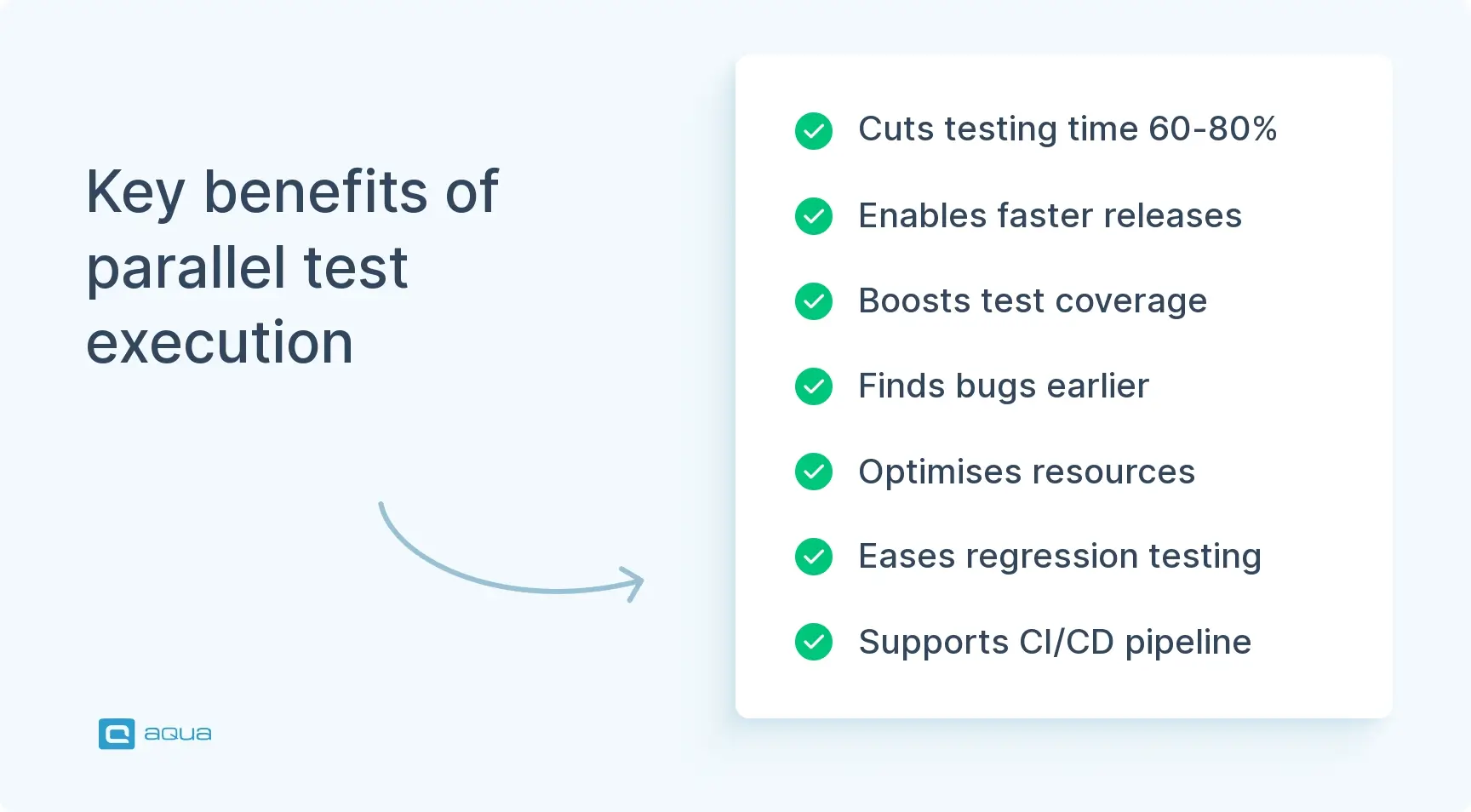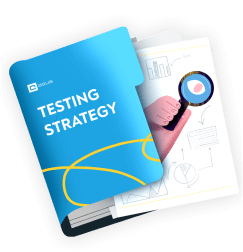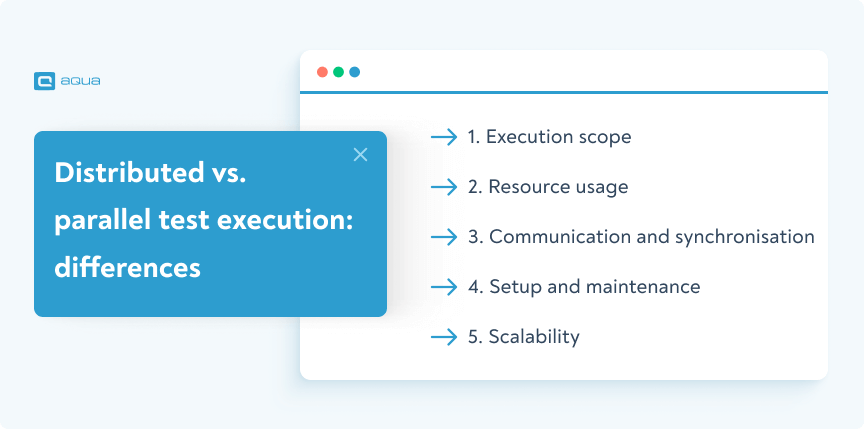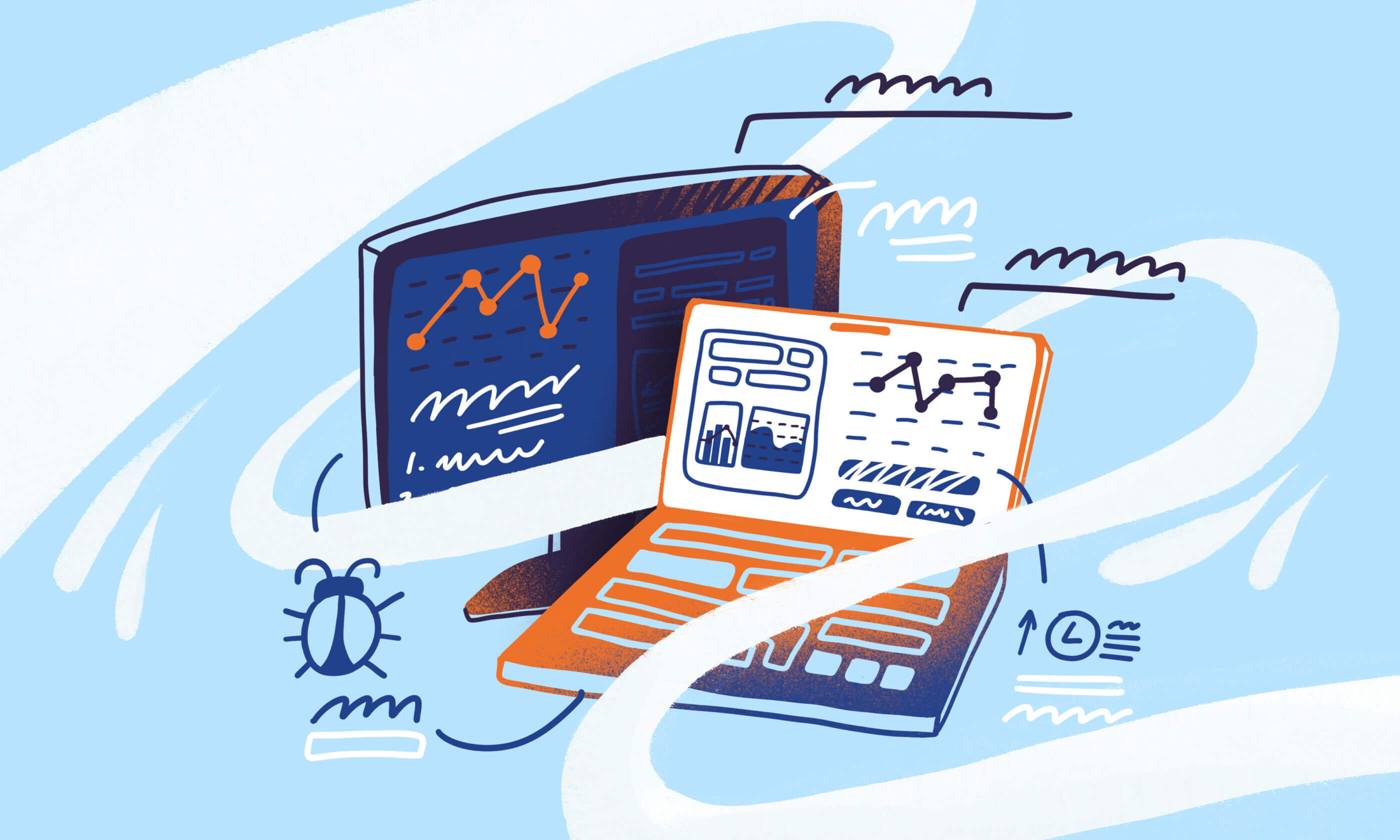We are talking about parallel test execution – a solution designed to address the very challenges that keep you up at night. You need to run tests simultaneously to cut testing time dramatically. This approach speeds up your CI/CD feedback loops and makes smart use of modern multi-core processors and cloud resources. And you do all that without sacrificing quality. Many teams see build times drop by half just by configuring their test runner properly. But how? In this article, we’re diving deep into managing parallel testing.
What is parallel test execution?
Parallel test execution is a testing strategy where you execute multiple test cases or test suites simultaneously rather than one after the other sequentially. This way, you aim to significantly reduce the testing time using modern hardware capabilities like multi-core processors and distributed computing environments.
Drop sequential testing’s slow feedback loop for parallel execution instead. You’ll slash testing cycles drastically and catch bugs far earlier by running tests simultaneously across multiple cores or machines.
Many teams see testing times cut by 60-80% when properly implemented. Just watch out for those shared test dependencies – they’re the number one killer of effective parallelisation. Your deployment pipeline will thank you.
12 benefits of parallel test execution
The benefits of parallel test execution are manifold and can significantly enhance the testing process’s efficiency, speed, and overall effectiveness. Here are some key advantages:
- Reduced testing time: Parallel execution allows multiple test cases or suites to be run concurrently, significantly reducing testing time.
- Faster time-to-market: The software can be released sooner with shorter testing cycles, helping you stay competitive and respond swiftly to market demands.
- Increased test coverage: Parallel execution allows for more tests to be executed in the same amount of time. This broader test coverage helps you identify a wider range of issues and ensures more comprehensive software testing.
- Early defect detection: Running tests in parallel can uncover defects and issues earlier in development when they are less costly and time-consuming.
- Optimal resource usage: Using available hardware resources effectively, such as multi-core processors or distributed computing environments, maximises resource utilisation and enhances testing efficiency.
- Enhanced scalability: Parallel execution can quickly scale to accommodate larger workloads without a proportionate increase in testing time.
- Improved collaboration: The approach allows development and testing teams to work concurrently with faster iterations and better collaboration.
- Efficient regression testing: When changes are made to the codebase, regression tests can be executed quickly, ensuring that new code modifications do not introduce defects or break existing functionality.
- Cost savings: Shorter testing cycles and quicker defect identification contribute to cost savings by reducing the need for extensive manual testing and subsequent bug fixing.
- Support for CI/CD: Parallel testing aligns seamlessly with CI/CD pipelines, enabling automated and efficient testing as part of development.
- Quick feedback loop: Rapid test execution gives developers faster feedback, helping them promptly address issues.
- Effective test data handling: Parallel execution can be coupled with strategies to manage test data effectively, ensuring that data dependencies do not hinder the testing process.

Ready to supercharge your testing and quality assurance efforts? Look no further than aqua’s testing strategy template — your ultimate roadmap to testing success. Designed to guide testers through every phase of software testing, this comprehensive template is your key to implementing parallel test execution, maximising resource utilisation, and accelerating your testing cycles. Say goodbye to prolonged testing timelines and hello to efficient, effective, and flawless software delivery.

Elevate your testing game today with aqua's testing strategy template
5 differences between distributed and parallel test execution
Distributed and parallel test execution are strategies used to accelerate software testing, but they have crucial differences in implementation, scope, and objectives. Here are five key differences between distributed and parallel test execution:
1. Execution scope:
Distributed test execution deploys tests across multiple machines to operate on separate aspects or configurations of the application. In contrast, parallel test execution runs multiple tests concurrently on a single machine using its CPU cores.
2. Resource usage:
Distribute your tests across machines for heavy workloads like multi-browser checks, or run them in parallel on local cores for quicker results. Cloud platforms work brilliantly here – they’ll scale your parallel tests almost effortlessly. Just watch out for shared resource dependencies when parallelising; they’re notorious bottlenecks that can actually slow things down.
3. Communication and synchronisation:
Distributed test execution involves communication and synchronisation complexities among distributed nodes due to centralised result aggregation, while parallel test execution on a single machine reduces communication and synchronisation overhead for quicker and more efficient testing.
4. Setup and maintenance:
Distributed test execution entails more intricate setup and maintenance due to configuration, network, and hardware considerations. In contrast, parallel test execution is typically simpler, relying on a single machine and its resources.
5. Scalability:
Distributed execution excels in scalability for extensive testing demands and diverse environments, while parallel execution, reliant on a single machine’s resources, can enhance testing speed and efficiency but may face scalability limitations.

How to perform parallel test execution?
Performing parallel test execution in testing requires careful planning, coordination, and implementation to ensure that multiple tests run simultaneously, optimising resources and accelerating the testing process. Here’s your step-by-step guide on how to execute parallel tests effectively:
1. Test suite analysis
- Divide your test suite into smaller, independent subsets of test cases.
- Discovered subsets should be logically organised and capable of running concurrently without dependencies.
2. Identify resource requirements
- Evaluate the hardware and computing resources available for parallel execution.
- Consider factors like CPU cores, memory, and network bandwidth to determine the optimal level of parallelism.
3. Test environment setup
- Create isolated and consistent test environments for each parallel execution.
- A solid environment helps prevent interference between tests and ensures accurate results.
4. Test data management
- Manage test data carefully to prevent conflicts and ensure data integrity during parallel execution.
- Use separate data sources or data copies for each test instance.
5. Automation framework
- Use an automation framework that supports parallel execution and is compatible with TMS, like aqua testing tool. The framework should handle test isolation, execution, and reporting seamlessly.
6. Parallel execution configuration:
- Configure your automation framework to execute multiple test subsets concurrently.
- This may involve specifying the number of parallel threads or processes used.
7. Test execution monitoring
- Implement monitoring tools to track the progress and status of parallel test executions.
- Real-time monitoring helps identify issues and bottlenecks.
8. Error handling and reporting
- Establish a robust error-handling mechanism to manage failures in parallel tests.
- Ensure that failed tests are accurately identified and reported.
9. Regression testing
- Apply parallel execution to your regression test suite to quickly validate code changes and maintain software quality during iterative development.
10. Optimisation and tuning
- Continuously analyse the performance of parallel execution.
- Adjust the parallelism and resource allocation level based on system capabilities and testing requirements.
11. Parallel testing
- Execute tests in parallel and compare the results with previous sequential runs to ensure consistency and accuracy.
12. Documentation
- Maintain clear documentation of the parallel execution process, including setup instructions, configurations, troubleshooting steps, and best practices.
13. Continuous improvement
- Regularly review the parallel execution strategy and optimise it based on feedback and lessons learned from each testing cycle.
14. Training and collaboration
- Train team members on parallel execution techniques and encourage collaboration to ensure successful implementation.
15. Testing scalability
- As your project grows, test the scalability of your parallel execution strategy to ensure it can handle larger workloads and more complex test suites.
Scaling Parallel Test Execution for Modern Development
Test suites ballooning? You’ll need smarter scaling for parallel execution. Cloud resources and tools like Docker and Kubernetes let you dynamically provision just what you need. The on-demand approach cuts costs while handling heavy workloads without breaking a sweat.
Implement smart test distribution. Instead of random allocation, try distributing tests based on historical run times – this simple change can slash overall execution time by 30% or more. Watch for resource bottlenecks too – CPU isn’t always the culprit; memory or network constraints can silently throttle performance.
Keep an eye on metrics, but don’t overdo it. Track just a few key indicators like queue time and resource utilization, then automate adjustments based on these signals. Building this elasticity into your testing pipeline means you’ll keep shipping at pace – whether you’re running 50 tests or 5,000.
Best Practices for Reliable Parallel Testing
Want your parallel tests to actually deliver? Stick to these proven practices. Make each test truly independent. Ditch those shared static objects and global variables that cause chaos. Instead, try thread-local storage – it keeps every test in its own little sandbox.
Test data management is huge here – generate unique values for each test run or set up data pools you can draw from without tests stepping on each other’s toes. And most importantly, clean up your mess afterwards. Nothing worse than leftover test data corrupting the next run.
Hardcoding test data that multiple parallel tests might fight over – don’t do it. Set up decent monitoring and central logging too – when tests fail (and they will), you’ll need to quickly spot whether it’s your test code, the app itself, or some environment hiccup causing trouble. Teams that nail these basics typically see their flaky test rates drop by half or more. Your parallel testing will finally do what it promised: deliver faster results you can actually trust.
Conclusion
Choosing the right approach in software testing can significantly impact your projects’ efficiency, speed, and overall success. While distributed execution shines in accommodating diverse testing scenarios and managing extensive workloads, parallel execution delivers a streamlined, faster testing process ideal for more compact projects. Striking the perfect balance between these strategies, tailored to project requirements and resource availability, is the cornerstone of achieving optimal testing outcomes.
Dive into the future of test management with a click


















